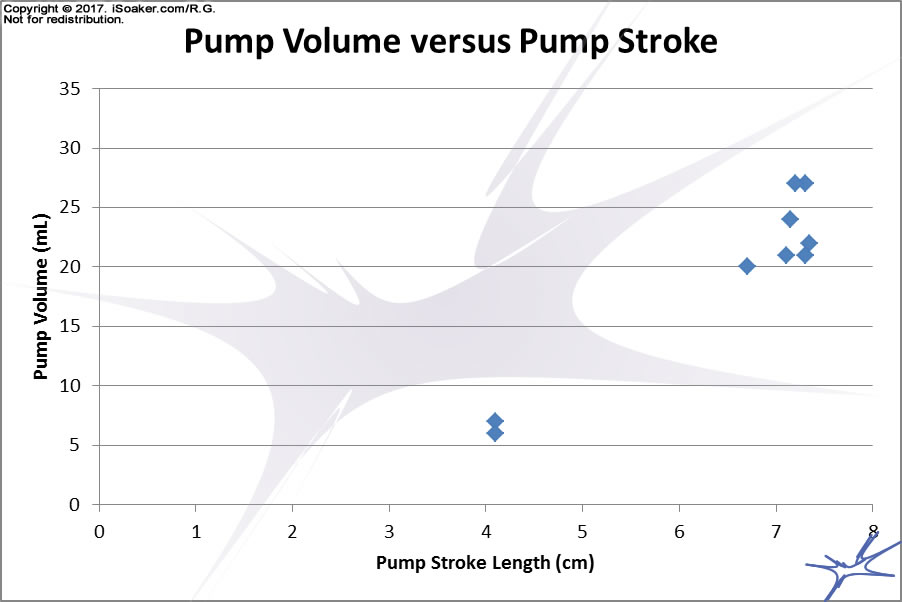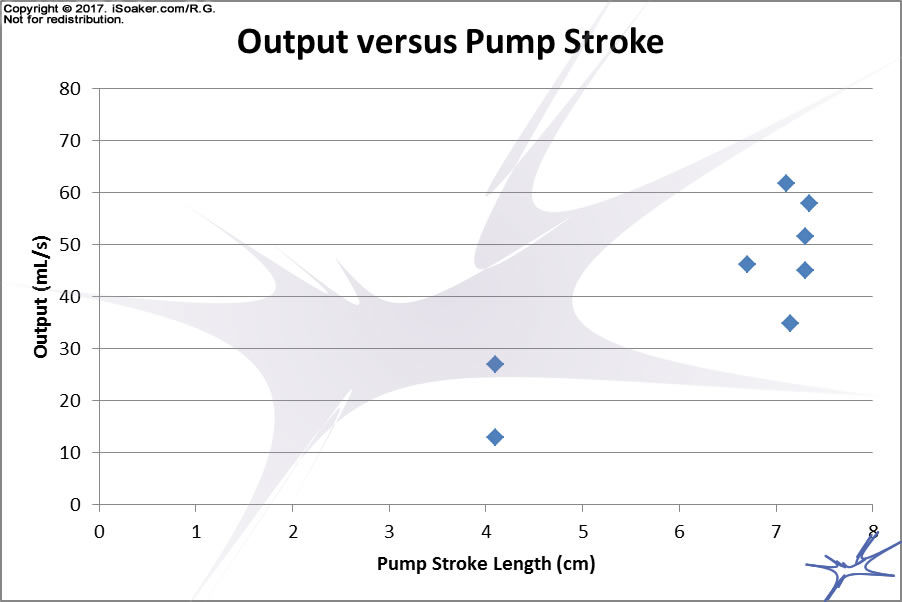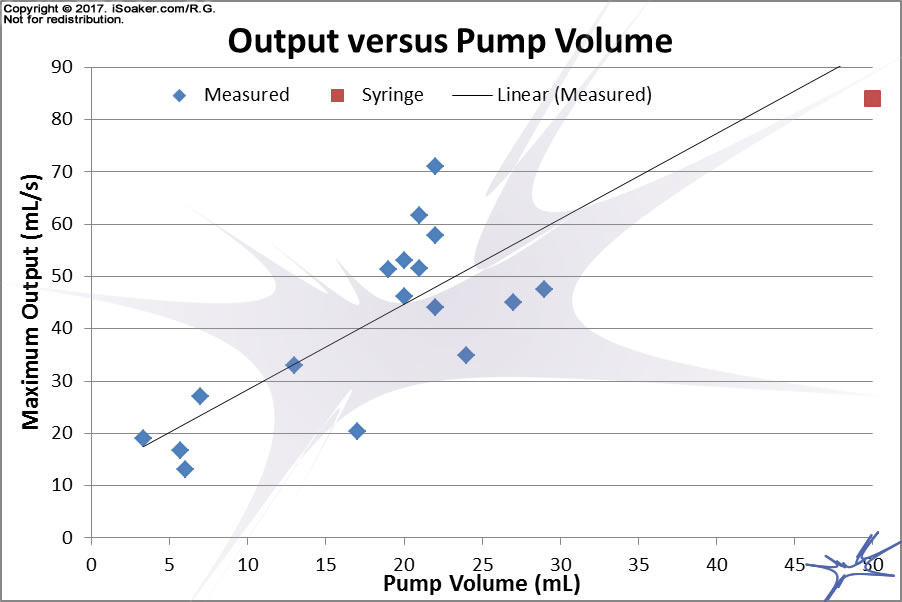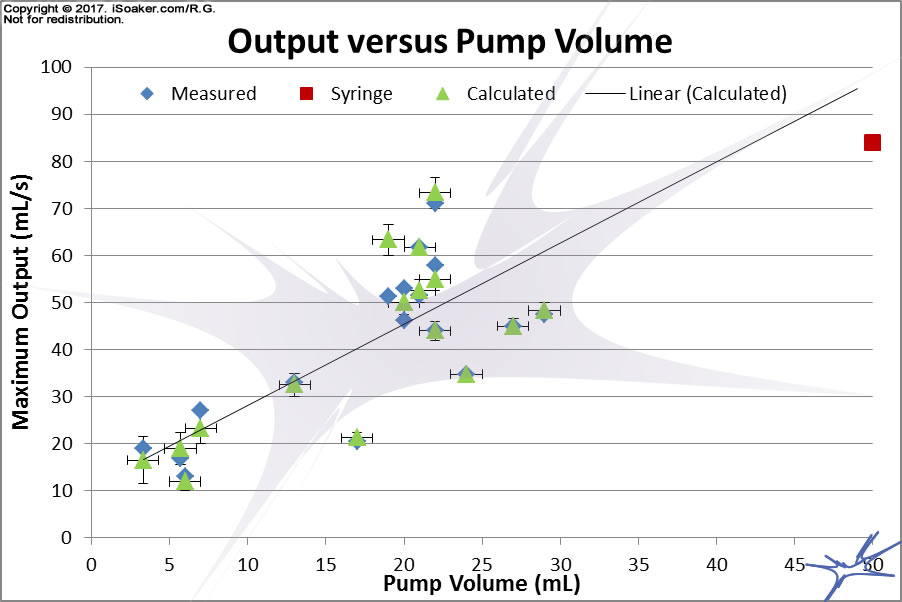
 Predicting Pump-Action Water Blaster / Water Gun Performance .:
Predicting Pump-Action Water Blaster / Water Gun Performance .:
Preamble .:
On February 15, 2017, after testing out a bunch of new-for-2017 pump-action water blasters, I decided to stop doing more detailed reviews on these type of water blasters. I felt that the range of performance and value of pump-action water blasters just did not justify the time and effort spent reviewing them as well as our readers' time reading such a review. This was not to say that there is no point to pump-action water blasters. I still appreciate virtually all water blasters. However, having handled hundreds of different water blaster models, I feel quite confident that all typically pump-action water blasters fall within a limited window of performance that should be somewhat easy to predict how a new model would behave. That was my theory: this article explores the accuracy of this statement.
For sake of argument, the following thoughts are meant for predicting the behavior of pump-action water blasters with on-board reservoirs that use pumps akin to their pressurized brethren. Syringe-type piston-based water blasters (e.g., Stream Machine or water blasters like Water Blaster Water Cannon, etc.) behave somewhat differently, though potentially similarly. However, the iSoaker.com database lacks sufficient data to do meaningful extrapolation based on the output performance of syringe-type water blasters.
Beginning with the End .:
For those not wanting to read through the entire article, here are the main takeaway points for most pump-action water blasters:
- expect most pump-action water blasters' output to fall within 30mL/s to 60mL/s (1oz/s to 2oz/s; or a 1x to 2x blast)
- to estimate output based on stroke length alone: [Estimated Output in mL/s] = ([Stroke Length in cm] * 9.6) - 19.5
- to estimate output based on pump volume alone: [Estimated Output in mL/s] = ([Pump Volume in mL] * 1.6) + 12
- both estimation formulae can predict most pump-action water blaster output within 15mL/s
- both estimation formulae fail for pumps with significantly different chamber internal diameters as well as for blasters that have large or small nozzles relative to their pump volume size
Sources of Measurement Errors .:
Of course, before diving into numbers and statistics, I have to admit there are a variety of sources of errors present in the statistics I measure, some sources being greater than others:
- Pump Stroke: This is a measurement of the distance traveled by the pump grip from its resting (fully compacted) position to its fully extended position. Some pump rods may jiggle or slightly bend when extended, but for the most part, this measurement can be done fairly accurately. Pump stroke length was measured using a set of calipers and should be between +/- 0.5mm
- Pump Volume: This is a measurement of how much water is moved per full pump stroke. In order to determine this without dismantling a water blaster (which also could affect the measurement), a water blaster must first be filled, then pump several times to ensure all internal tubing is also filled with water (often, the first couple of pumps primarily eject air from the nozzle as water begins filling the internals). One source of error is the possibility for some small lingering air bubbles to be trapped either within the pump or within other parts of the tubing. If an air bubble is released during the measuring phase, this will result in reduced volume measured. There is also potential error if a pump's seals are not functioning correctly that may result in less water moved per pump cycle than should be. There is also the problem of leaky, dribbling tubing that may result in more water exiting the nozzle after pumping than was actually moved during the pump cycle. The minimize all these sources of error, a lot of care is taken when priming the water blaster being tested, doing several pumps with a full reservoir at large angles both to expel air and ensure all tubings are properly flushed with water. Pump performance is also assessed during the filled stage; if a pump feels to be functioning abnormally, the volume for that particular model is not recorded or recorded with a note until another water blaster of the same model can also be tested. Moreover, outflow from the nozzle is examined for residual flow post-pumping. If there are any concerns about dribbling, adjustments are made to the measuring process to compensate and not capture excess flow (typically accomplished by moving the nozzle away from the water receptable post-pump). To top things off, pump volume is measured by doing multiple pumps and averaging, then repeating. By doing so, this also helps compensate for variations in single pump cycles. Despite all this, pump volume accuracy is believed to fall within +/- 1mL.
I should note that this method of determining pump volume could be referred to as measuring "Functional Pump Volume". The theoretical pump volume could be calculated by knowing the length of the pump stroke and multiplying that by the area of the inside of the pump based on its inner diameter. However, the actual volume moved by the pump through the nozzle also depends on how quickly various valves open and close, how good the seal on the pump is, and how tight and leak-proof the internal tubing is. As such, I prefer knowing how much water is actually moved, not simply what the volume might theoretically be.
- Shot Time: This measurement denoted how long a stream is produced by a water blaster; for a pump-action water blaster, their streams typically last only for as long as the pump if being compressed/moved. Most pump-action water blasters shoot for less than 1 second with most having a shot time under 0.5 seconds. Thanks to taking videos of stream production, accuracy of pump-action shot times is estimated to be within +/- 0.05 seconds.
- Output: This statistic is calculated for pump-action water blasters by taking the average measured pump volume and dividing that by the average measured shot time to yield output in mL/s. As error level grows as statistics are combined, the estimated error in output is ~ +/- 1-3mL/s
Pump Dimensions .:
If one could measure the pump stroke and the inner diameter of the pump chamber of a water blaster model, one could then calculate the theoretical maximum volume that should be moved for each full pump cycle. In practice, while pump stroke length is not too difficult to measure, many pumps are now fairly well hidden or buried within the casing of various water blaster models, making it impossible to do a direct measurement of a pump chamber's internal diameter without dismantling the water blaster. I should also note that Users often cannot achieve the theoretical maximum volume per stroke as well if they do not fully extend the pump before compressing it or if they happened to be moving while pumping, causing air to be drawn into the intake tubing instead of water during part of the pump cycle.
Nevertheless, based on the measurement of nine (9) different pump-action water blaster models tested, we examined how well pump stroke alone could be used to estimate pump volume.
Not surprisingly, water blasters with shorter pump strokes tended to have lower measured pump volumes. For the typical pump stroke of about 7.0cm-7.5cm, measured pump volumes appeared for fall within 10mL of each other. While not perfect, at least for a typical pump-action water blaster, if the pump stroke length is roughly 7cm, one should expect the water blaster to push between 20mL to 30mL each pump.
However, as can be seen above, when trying to use pump stroke length alone to make predictions about output, the points are far more spread due to the variability in actual water volume pumped per stroke. Nevertheless, while there is variability in the pump chamber inner diameters leading to a sub-optimal spread, the range of output is still clustered within approximately +/- 15mL/s (~0.5oz/s). As such, while not as accurate as I had hoped, one can still get a decent approximation of expected output using the following formula:
[Estimated Output in mL/s] = ([Stroke Length in cm] * 9.6) - 19.5
Pump Volume .:
While I did not typically measure the pump stroke length of many water blaster models, I was always interested in knowing pump volume for water blasters that pushed water (not air) through their pumps. As such, the number of measurements I have for functional pump volume far exceeds that for pump stroke length.
As an be seen above, there are two clusterings of measured pump volume: one in the lower 3mL to 8mL range and one in the higher 20mL to 30mL range. Looking more at the trends, the clustering at the lower volumes is tighter than that for the higher volumes. While initially surprising, the variability can be explained as follows: since the pump-action water blaster has a rather limited, finite amount of water available per shot, when output increases, effective range will correspondingly decrease. In order to provide an acceptable level of performance, when a water blaster pumps low volumes (less than 10mL), output cannot be too high, otherwise stream range would drop too far and become unacceptable to most users. For pump-action water blasters that hold more water in their pumps, output can deviate higher from average as there is enough water available to produce a decently performing stream. Considering that most pumps measure in at 30mL or less, an output of roughly 60-70mL/s appears to be the upper limit for output that achieves decent distance (e.g., at least 8m (~26'), but preferably ~9m (~30')) The lower end of the spectrum for pump volumes above 20mL appears to be an output of 30mL/s (~1 oz./s) with the majority falling somewhere in the 45mL/s (~1.5oz./s) range.
Taking measurement variations/errors into consideration, some of the points may deviate from reality to some degree, but the general trend appears to hold well. As such, the formula for using pump volume for estimating output appears to work out to be:
[Estimated Output in mL/s] = ([Pump Volume in mL] * 1.6) + 12
Interestingly, using this equation, even the Nerf Super Soaker Rebelle Wave Warrior water gun fits fairly closely to this approximation as can be seen by the "red" upper-right point on the graph above.
Variation in output performance likely stem from variations in nozzle diameter, internal tubing configuration, and nozzle geometry.
Predictions (Updated: 20170307) .:
Not included in the above data (since they were not originally measured) are statistics for the Xshot Typhooon Thunder (Zuru) and Adventure Force Hydro Blitz (Prime Time Toys). Here are the results based on pump volume:
| Name | Pump Volume (mL) | Measured Output (mL/s) | Calculated Output (mL/s) | Difference |
| Adventure Force Hydro Blitz | 17 | 34 | 39.2 | 5.2 (15.3%) |
| Xshot Typhoon Thunder | 21 | 42.5 | 45.6 | 3.1 (7.3%) |
With even a 15% difference for the Adventure Force Hydro Blitz output, most casual users would not likely notice any meaningful difference even if the difference increased to 50%.
The Outliers .:
The two formulae appear to work decently for many of the pump-action water blasters tested. However, looking at the graphs, one can also easily see that there are a few points that seem oddly high or low given either the measured pump stroke or pump volume.
Notably Higher Output: Nerf Super Soaker Barrage - despite having the same measured pump volume as other pump-action water blasters such as the Nerf Super Soaker Zombie Strike Revenge Infector and the Nerf Super Soaker Tri Strike Crossbow, the Barrage manages to have a higher maximum output on its largest setting thanks to its significantly larger nozzle opening. However, at its larger nozzle setting, it loses roughly 1.5m (~5') for the maximum range of its stream
Notably Lower Output: Nerf Super Soaker Shotwave - the Shotwave is an abberation in the other direction; while its pump volume is only ~3/4 that of the Barrage, its output is 1/3 the Barrage's maximum output and approximately 1/2 of what the formula above for Output versus Pump Volume gives. For the Shotwave, its problems likely stem also from its nozzle being on the small side even for its reduced volume pump.
Conclusions .:
Based on the statistics I have available so far, we have derived two formulae for allowing one to make a decent estimate on the expected output for pump-action water blasters. They are:
- to estimate output based on stroke length alone:
[Estimated Output in mL/s] = ([Stroke Length in cm] * 9.6) - 19.5
- to estimate output based on pump volume alone:
[Estimated Output in mL/s] = ([Pump Volume in mL] * 1.6) + 12
While there are some exceptions to these formulae, these appear to primarily stem for differences in nozzle opening diameter. Considering that the majority of pump-action water blasters fall within a 1x to 2x stream rating (i.e. 30mL/s to 60mL/s; 1oz./s to 2oz./s), even if these formulae are somewhat off, the calculated values should provide a reasonable estimate of the actual output.
All that said, output alone is not a guarantee of truly satisfying stream performance. Good streams must not only have decent output, but also should have good lamination/consistency in order to be able to reach further distances. I did look at output versus recorded ranges, but as can be seen below, there unfortunately appears to be no strong linear correlation.
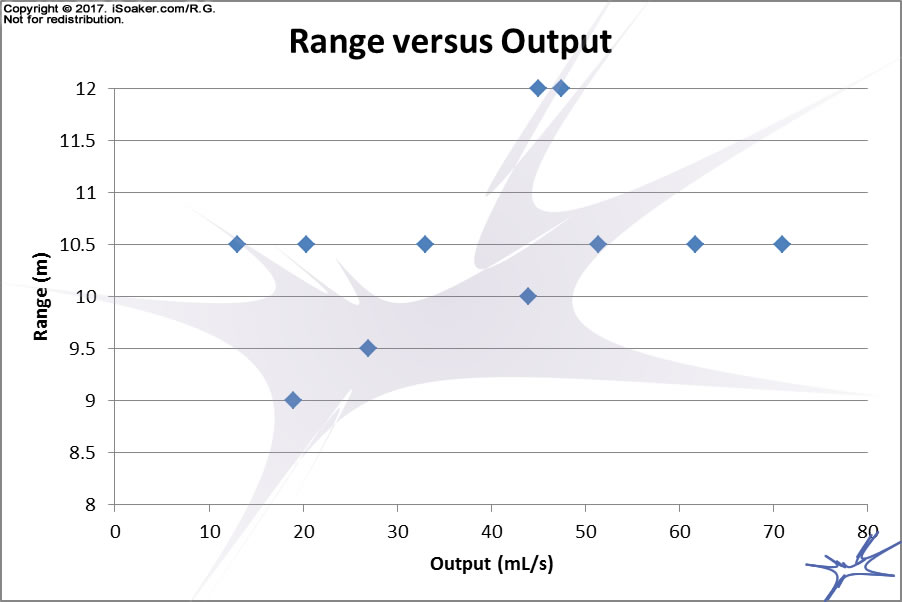
In the end, expect most pump-action water blaster to yield a 1x to 2x stream, achieve somewhere between 25' to 35' effective range, and have their capacity dependent on the blaster's overall physical size. Deviations from this would be due to sub-optimal internal tubing arrangements and/or peculiar nozzle designs.
Soak on!

